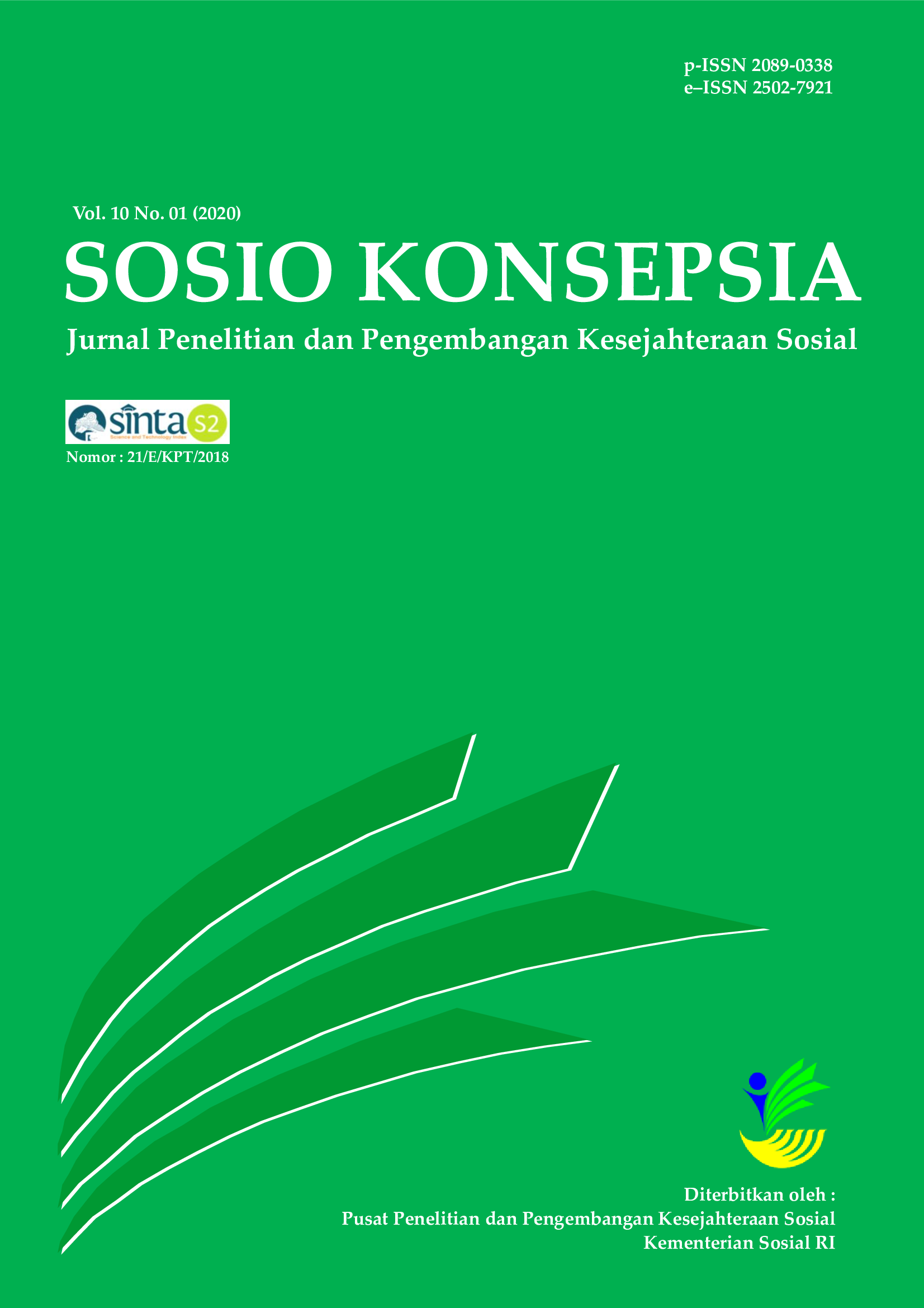Published 2020-12-28
How to Cite
Abstract
Drug abuse is a quite serious problem and its handling involves various stakeholders. This study aims to analyze how the influence of family communication on the assertiveness of adolescent drug abusers. This study used a cross-sectional study design and was carried out at National Narcotics Agency, Jakarta Timur City (BNNK), Jakarta Timur and Non-Governmental Organizations under the guidance of the BNNK, Jakarta Timur namely: Balarenik Foundation and Swara Peduli Indonesia Foundation. The selection of research locations is done by snowball sampling. The population of this study is adolescent drug abusers in  Jakarta Timur, Jakarta. The respondents of this study were 68 adolescent drug abusers in BNNK, Jakarta Timur, Balarenik Foundation, and Indonesian Swara Care Foundation. The sampling technique in this study uses non-probability sampling with purposive sampling. The findings in this study are that there is a significant positive effect of family communication on adolescent assertiveness. The determinant coefficient in this study was 62%, which means that the assertiveness of adolescent abusers of narcotics is determined by the communication of the of family of 62% and 38% is determined by other factors.
Downloads
References
- Alberti, R., & Emmons, M. (2002). Your Perfect Right Panduan Praktis Hidup Lebih Ekspresif dan Jujur pada Diri Sendiri. Jakarta: Elex Media Komputindo.
- Anindyajati , M., & Karima , C. M. (2004). Peran Harga Diri Terhadap Asertivitas Remaja Penyalahguna Narkoba (penelitian pada remaja penyalahguna narkoba di tempat-tempat rehabilitasi penyalahguna narkoba). Jurnal Psikologi, 2(1).
- Ardianto. (2016). Pengaruh Komunikasi Positif dalam Keluarga dan Komunikasi Interpersonal Guru terhadap Perilaku Asertif Siswa. 1(2), 82-98.
- Arikunto, S. (2010). Prosedur Penelitian Suatu Pendekatan Praktik. Jakarta: Rineka Cipta.
- Bedell, J. R., & Lennox, S. S. (1997). Handbook for Communication and Problem-Solving Skills Training: A Cognitive-Behavioral Approach. New York: Jhon Wiley & Sons.
- Breitman, P., & Hatch, C. (2001). How to Say No Without Feeling Gulity.
- Cangara, H. (2002). Pengantar Ilmu Komunikasi. Jakarta: PT. Raja Grafindo Persada.
- Devito, J. A. (2011). Komunikasi Antarmanusia. Tangerang Selatan: Karisma Publishing Group.
- Djamarah, S. B. (2004). Pola Komunikasi Orang Tua dan Anak Dalam Keluarga. Jakarta: Rineka Cipta.
- Effendy, P. U. (2002). Ilmu Komunikasi dan Praktek. Bandung: PT. Remaja Rosdakarya.
- Fajar , M. (2009). Ilmu Komunikasi: Teori & Praktek. Yogyakarta: Graha Ilmu.
- Fensterheim, H., & Baer, J. (2005). Jangan Bilang Ya Bila Anda Akan Mengatakan Tidak. (Buditjahya, Trans.) Jakarta: Gunung Jati.
- Friendly. (2002). Komunikasi dalam Keluarga. Jakarta: Family Altar.
- Galassi, M. D., & Galassi, J. P. (1977). Assert Your Self: How To Be Own Person. New York: Human Sciences Press.
- Goleman, D. (2000). Emotional Intelligence Kecerdasan Emosi Mengapa EI Lebih Penting daripada IQ. (Hermaya, Trans.) Jakarta: PT. Gramedia Pustaka Utama.
- Hartati, H., Dimyati, M., & Herdi. (2014). Pengaruh Pelatihan Asertif Untuk Meningkatkan Asertivitas Terhadap Penyalahguna Narkoba.
- Hasanah, Atul. (2015). Pengaruh Perilaku Teman Sebaya terhadap Asertivitas Siswa. Indonesian Journal of Guidance and Counseling Theory and Application, 4(1), 22-29.
- Hurlock, E. (1997). Psikologi Perkembangan: Suatu Pendekatan Sepanjang Rentang Kehidupan. (Istiwidayanti, Trans.) Jakarta: Erlangga.
- Jovan, B. (2015). Peranan Komunikasi Keluarga Dalam Pembentukan Identitas Remaja di Kelurahan Malalayang I Kecamatan Malalayang Kota Manado. E-Journal, IV(4).
- Liliweri, A. (1997). Komunikasi Antar Pribadi . Bandung : Cipta Aditya Bakti.
- Mangkuprawira, T. S., & Hubeis, A. V. (2007). Manajemen Mutu Sumber Daya Manusia . Bogor: Ghalia Indonesia .
- Maria , U. (2007). Peran persepsi keharmonisan keluarga dan konsep diri terhadap kecenderungan kenakalan remaja. Jurnal Penelitian Psikologi .
- Marini, L., & Andriani, E. (2005). Perbedaan Asertivitas Remaja ditinjau dari Pola Asuh Orang Tua. Jurnal Psikologi, 1(2).
- Onyeizugbo, E. U. (2003). Effect of Gender, Age, and Education on Assertiveness in a Nigerian Sample. 12-16.
- Ramadhani , S. (2008). The Art of Positive Communicating: Mengasah Potensi dan Keperibadian Positif Pada Anak Melalui Komunikasi Positif. Yogyakarta: Bookmarks.
- Riduwan. (2004). Metode & Teknik Menyusun Tesis . Bandung.
- Sumakul, B. J. (2015). Peranan Komunikasi Keluarga dalam Pembentukan Identitas Remaja di Kelurahan Malalayang I Kecamatan Malalayang Kota Manado. ACTA DIURNA KOMUNIKASI, 4(4).
- Scherer, K. R., Schorr, A., & Johnstone, T. (2001). Series in affective science. Appraisal processes in emotion: Theory, methods, research. New York: Oxford University Press.
- Setyawan. (2009). Assertive Training. E-Journal. doi:https://doi.org//htp://setyafi.multiply.com/journal/item/11/Assertive_Trainingshow_interstitial.journalitem
- Silitonga, M., Yulastri, L., & Artanti, G. D. (2014). Hubungan Pola Asuh Orangtua dengan Agresivitas Anak di SMPN 194 Jakarta Timur'. Jurnal Kesejahteraan Keluarga dan Pendidikan,(Online), 2(1), 6-9.
- Sugiyono. (2016). Metodologi Penelitian Pendidikan, Pendekatan Kuantitatif, Kualitatif, dan R&D. Bandung: CV Alfabeta.
- Syukri, M. R., & Zulkarnain. (2005). Asertivitas dan Kreativitas Pada Karyawan yang Bekerja di Multi Level Marketing. Jurnal Psikolog, 1(2).
- Tjalla, A., & Novianti, M. C. (2008). Perilaku Asertif Pada Remaja Awal.
- Unal, S. (2012). Evaluating the effect of self-awareness and communication techniques on nurses’ assertiveness and self-esteem. Contemporary nurse, 43(1), 90-98.
- William, C. (2008). Cognitive Behavior Therapy Within Assertive Outreach Team: Barriers to Implementation: a qualitative peer audit. Journal of Psychiatric and Mental Health Nursing, 850-856.





